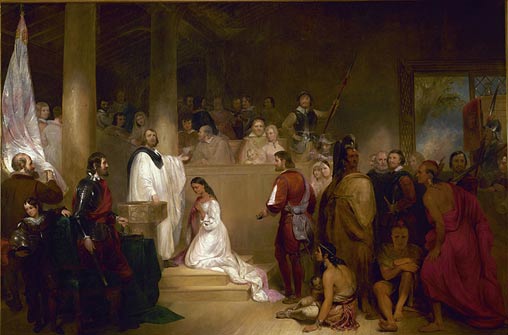
The True Story of Pocahontas as NOT told by Disney
Pocahontas is remembered as the Native American Powhatan princess who saved the life of Englishman John Smith, married John Rolfe and fostered peace between English settlers and Native Americans. In 1995, Disney released an artistically beautiful animated film showing the supposed events that unfolded between John Smith and Pocahontas. Although Disney is known for creating fictional tales, many people believe that Disney’s account of the life of Pocahontas was a true reflection of past events: the love between Pocahontas and John Smith, the bravery Pocahontas showed when saving John Smith’s life, and the tragic ending when John Smith returned to England for medical treatment. However, this depiction is a far departure from the actual events that occurred, and from the real life of Pocahontas.

Disney produced a romanticized and inaccurate portrayal of the life of Pocahontas. (fanpop.com)
It is believed that Pocahontas was born around 1595 to a Powhatan chief. Her given name at birth was Matoaka, although she was sometimes called Amonute. “Pocahontas” was a derogatory nickname meaning “spoiled child” or “naughty one.” Matoaka’s tribe was a part of a group of about thirty Algonquian-speaking tribes located in Tidewater, Virginia.
During Matoaka’s childhood, the English had arrived in the ‘New World’ and clashes between the colonizers and the Native Americans were commonplace. In 1607, John Smith, an Admiral of New England and an English soldier and explorer, arrived in Virginia by ship, with a group of about 100 other settlers. One day, while exploring the Chickahominy River, John Smith was captured by one of Powhatan’s hunting parties. He was brought to Powhatan's home at Werowocomoco. The accounts of what happened next vary from source to source. In John Smith’s original writing, he told of having a large feast, after which he sat and spoke with Chief Powhatan. In a letter written to Queen Anne, John Smith told the story of Matoaka throwing herself across his body to protect him from execution at the hands of Powhatan. It is believed that John Smith was a pretentious man who told this lie to gain notoriety. In the Disney version, Matoaka/Pocahontas is depicted as a young woman when she saved John Smith, but by his accounts, she was only a 10-year-old child when these events occurred, and therefore highly unlikely that there was any romance between them.

‘John Smith Saved by Pocahontas’ by Alonzo Chappel, circa 1865, based off his wood carving from 1861, currently on display in the Art Museum of Western Virginia. (Wikimedia)
Matoaka often visited the settlement at Jamestown to help the settlers during times when food was in short supply. On 13 th April, 1613 AD, during one of these visits, Samuel Argall captured Matoaka to ransom her for some English prisoners held by her father. She was held hostage at Jamestown for over a year. During her captivity, tobacco planter John Rolfe took a ‘special interest’ in the attractive young prisoner, and he eventually conditioned her release upon her agreeing to marry him. Matoaka was baptized ‘Rebecca’ and in 1614, she was married John Rolfe - the first recorded marriage between a European and a Native American.

The Baptism of Pocahontas by John Gadsby Chapman (Wikimedia). Chapman depicts Pocahontas wearing white, being baptized Rebecca by Anglican minister Alexander Whiteaker in Jamestown, Virginia. She kneels, surrounded by family members and colonists. Her brother Nantequaus turns away from the ceremony. The scene symbolizes the belief at the time that Native Americans should accept Christianity and other European ways.

Marriage of Matoaka to John Rolfe. From ‘Pocahontas: Her Life and Legend’ by William M. S. Rasmussen. (Wikimedia). Their union is said to be the first recorded marriage between a European and a Native American.
Two years later, John Rolfe took Matoaka to England to use her in a propaganda campaign to support the colony of Virginia, propping her up as the symbol of hope for peace and good relations between the English and the Native Americans. ‘Rebecca’ was seen an example of a civilized ‘savage’ and Rolfe was praised for his accomplishment in bringing Christianity to the ‘heathen tribes’.
While in England, Matoaka ran into John Smith. She refused to speak with him, turning her head and fleeing from his presence – a far cry from the undying love between the two as portrayed in the Disney movie. In 1617, the Rolfe family boarded a ship to return to Virginia. However, Matoaka would not complete this journey home. She became gravely ill – theories range from smallpox, pneumonia, or tuberculosis, to her having been poisoned – and she was taken off the ship at Gravesend where she died on March 21, 1617. It is believed she was 21 years old when she died. Sadly, there were no fairy tale endings for Matoaka.

Statue of ‘Pocahontas’ in Historic Jamestowne, Virginia, USA. But does the commemorative statue honor her real life? (Wikimedia)
The real story of ‘Pocahontas’ would make a greater movie than the one produced by Disney, as her tragic life
Featured image: Depiction of Pocahontas ( likoper / Adobe Stock)
References
Pocahontas – Biography. Available from: http://www.biography.com/people/pocahontas-9443116#synopsis.
The Pocahontas Myth – Powhatan.org. Available from: http://www.powhatan.org/pocc.html.
The Real Story Of Pocahontas Is Much Darker Than The Disney Movie – Business Insider. Available from: http://www.businessinsider.com.au/the-real-story-of-pocahontas-2014-4.
Pocahontas – Wikipedia. Available from: http://en.wikipedia.org/wiki/Pocahontas.
By M R Reese
















Comments
horrível o jeito que vocês brancos trataram e tratam nós índios.. nós sempre tratamos vocês bem
This to me is a very sad story. Both the fiction created by Disney and supposedly the true story. What is sad is that how colonial whites created stories often pure lies to define and emphasise their superiority. It must have been very sad for this young lady to die in a foreign land. I can imoagine Gravesend in the 16 century, it must have been a dreary place to die, it is not Much better now!
I do think the true story is very interesting however trying to say Disney is painting it in a bad light is wrong. They wanted to tell the story of a girl who tried making peace between the settling whites and the Indians. Like all their movies they are targeted as children and to fit with the princess films had a romantic story line. No one really believes that cinderella is true, they also made a second where she travels to England with John Rolfe, this obviously changes facts also as it is made for childs entertainment but it shows how she was paraded about and how horrid and ignorant the king and other English people were to her customs.
I think the Disney version is a lovely fairy tale but it is just that, a story made lighter hearted and happier than the real events. She is still shown to be a courageous woman and someone that girls could look up to.
You didn't mention the fact that Pocahontas had a daughter with a brave and she married Thomas Pettis/Pettus. This has been known by the three tribes that are Pocahontas's dependents. I wish people would fact check their stories with Native peoples, you may learns something new.
really why would you say disney is pulling a fast one the pochahontas move didn't even go on for that long and eventually faded away
Pages